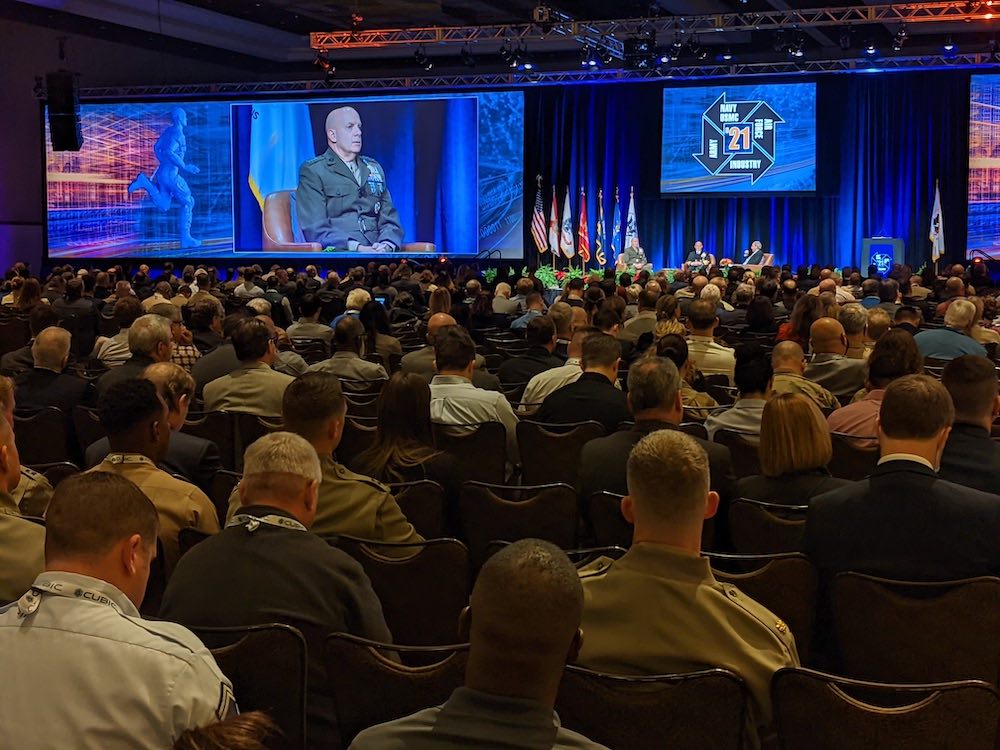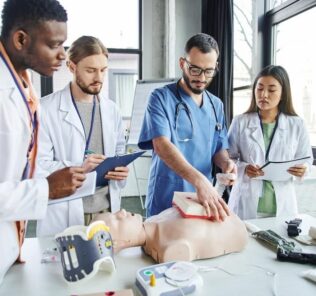I/ITSEC 2021 Showcases U.S. Defense Investments Into Simulated Training
This week in Orlando Florida, the 2021 Interservice/Industry Training, Simulation and Education Conference (I/ITSEC) opened with the Congressional Modeling and Simulation Caucus signature event, which included Congressman Bobby Scott, Stephanie Murphy, and Jack Bergman. I/ITSEC, which is organized by the National Training & Simulation Association (NTSA), is seen by the global simulation community as one of the leading military simulation events which has continued to expand its support of medical simulation over the past decade. HealthySimulation.com was on hand to capture discord around healthcare simulation as well as to witness the latest in clinical simulation technologies.
About I/ITSEC
The Interservice/Industry Training, Simulation and Education Conference (I/ITSEC) is the world’s largest modeling, simulation and training event. Held near the beginning of December in Orlando, Florida, USA, I/ITSEC consists of peer-reviewed paper presentations, tutorials, special events, professional workshops, a commercial exhibit hall, a serious games competition, and STEM events for teachers and secondary students. I/ITSEC is organized and sponsored by the National Training & Simulation Association (NTSA), which promotes international and interdisciplinary cooperation within the fields of modeling and simulation, training, education, analysis, and related disciplines at this annual meeting. The NTSA is an affiliate subsidiary of the National Defense Industrial Association (NDIA). Hence, I/ITSEC also emphasizes themes related to defense and security.
Sponsored Content:
Monday’s Congressional Caucus
This special event, hosted by Rear Admiral James Robb USN (Ret), President of the National Training and Simulation Association, invited everyone attending the conference or exposition to hear from the training and simulation leaders in Congress. It is also a great opportunity for the audience to interact with Congressional Members on issues of importance. With defense budgets constantly in flux, this forum provided an opportunity to advocate for the value of training and simulation in support of national security. Attendees heard from the leadership of the Modeling and Simulation Congressional Caucus on their perspective of the situation in Washington and have the opportunity to make their case for timely investments in modeling and simulation. With every budget dollar being scrutinized, strong advocacy for training and readiness has never been more important.
Representative Bob Scott, Virginia 3rd District and Chairman of the Committee for Education and Labor, which has been extremely busy trying to overcome COVID19 challenges over the past two years. Congressman Scott reminded the audience that Biden’s Build Back Better plan has specific stipulations to utilize simulation tools to ensure job training for a skilled workforce, and as well to ensure manufacturing and services are effective investments. He then thanked the audience for their dedication to improving the United States through the use of simulation in the military, aviation, healthcare, and all other industry sectors.
Representative Stephanie Murphy, Florida 7th District, represents the Orlando area which has become one of the leading regions supporting the technological development of simulation across industry sectors. She reminded the audience that Orlando’s support of digital twin technology will have massive impacts for improving efficiency for design, construction, manufacturing or training. Representative Murphy shared about an upcoming DoD modeling and simulation competition, rewarding up to $5M to simulation and modeling companies for bringing innovative ideas to working concepts. She sees a huge opportunity for simulation and modeling to improve service-member training, reduce costs, and increase efficiency. Speaking on the metaverse specifically, Representative Murphy highlighted the importance of serious games in the organization’s future.
Sponsored Content:
Representative Jack Bergman, Michigan 1st District, is a retired United States Marine Corps lieutenant general and served as commanding general of the Marine Forces Reserve and the Marine Forces North. He serves on the House Armed Services Committee and the Veterans Affairs Committee. As a pilot, Representative Bergman reminded the audience that in the aviation industry, failing a flight simulation could cost you your job — and that was the way it should be. He suggested making simulation as real as possible, and to do that, simulator manufacturers need to ensure they get “inside the head” of learners.
Representative John Rutherford, Florida 4th District, was unable to attend the event but sent a recorded message suggesting that the simulation industry enables the United States to produce more effective technologies and outpace other nation states in national defense, but also medicine, business systems and beyond. Simulation, he suggested, is a great way to figure out if an idea has any potential in a cost-effective way where failure did not require much effort.
Taking questions from the audience, Admiral Robb asked “Do we need to do more mandating of simulation and checklists in healthcare, like they do in the aviation industry?”
Representative Bergman answered “Yes. There are 400,000 deaths due to medical error estimated annually. If you had that kind of death in the aviation industry you think you would change the way the train? There is a struggle in the medical community, because they are afraid of losing licenses for errors. For me, the type of simulation training needed is exactly the same as it is for planes, where if you fail a flying simulation, you can lose your job. People are dying unnecessarily, and get the belief going amongst the surgeons that this is not only value added, to improve our capabilities, but also benefits the patients.
Representative Scott shared “I agree 100% with Representative Bergman. We have a shortage of workers across the healthcare system, and the more we can use sim to combat that, the better off we will be”.
Robb also asked Representative Murphy about XR (Mixed Reality) technologies and the metaverse, about how it relates to national defense and Simulation and Modeling. Representative Murphy suggested that the “uses are endless”, which enables us to “access all of that data and play out countless situations with unlimited iterations”. She believes there is so much power in this parallel universe of sorts where we can test things out without hurting people in the process.
Finally, Admiral Robb asked how we can support the representatives in their mission to empower simulation and modeling. Representative Scott reminded the audience to share your simulation success stories with your local, state, and federal government representatives so that they know how powerful your work is and how it impacts their constituents. Representative Bergman said he welcomed participants to bring their innovative show and tell technologies to Washington and that he would certainly help to showcase them to the rest of Congress, to show people how important modeling and simulation is to the future of the United States.
From the Exhibit Hall so Far
Touring the exhibitor spaces provides attendees with the opportunity to see the latest in simulated technologies, from cutting edge view screens to the latest VR hardware, and from autonomous moving target robots for combat practice to the new SimMan 3G Plus. Primarily based for military training, the event still had plenty of healthcare centered simulation companies demonstrating their wares, including CAE Healthcare, Echo Healthcare, TacMed, Operative Experience Inc, ArchieMD, VRGluv, Varjo, RiVR, Laerdal, Safeguard Medical, BodyAI and VCom3D to name a few.
CAE Healthcare, a division of Canadian-based aviation training company CAE, showcased its manikin-based patient simulator technologies alongside its world-leading flight simulators. Echo Healthcare demonstrated its hyper realistic Lifecast Body Simulation manikins and lifelike EchoMasks which enable educators to quickly change the gender, age or ethnicity of patient simulators or standardized patients. TacMed, OEI, Safeguard Medical, Gaumard and Laerdal also showed off their unique trauma patient simulators.
Laerdal also showed off the SimMan 3G Plus, which is the improved patient simulator replacing the standard SimMan 3G and now comes with articulating arms, realistic silicon skin, Sp02 finger capabilities, blood pressure readings from real cuffs, and more.
VCom3D showed off an impressive new technology with their virtual patient IPE training tool which directly connected to a proprietary patient simulator, wherein actions taken on the virtual patient affected the physical patient in real-time, and vice versa. Built to work off the Moses platform, the ability to work in a virtual and a real-life engagement simultaneously was impressive.
Also on display were 360 training tools from RiVR, VR training headsets and training platforms from Varjo, haptic VR gloves for feeling virtual experiences with VRGluv, simulated body physiology from BodyAI, and virtual patient training from ArchieMD.
Additionally, service and support organizations and military purchasers such as the National Center for Simulation, the National Training and Simulation Association (NTSA), Tech Grove Orlando Collation, and DHA’s Program Management (Peo).
NTSA President Admiral Robb shared online that “the 2021 The Interservice/Industry Training, Simulation and Education Conference that kicks off this week is dedicated to support all these visions and brings the training and simulation community together to assess and debate requirement and to share ideas on how to build and train a better force.”
General David H. Berger, 38th Commandant of the Marine Corps, and Admiral Michael M. Gilday, Chief of Naval Operations, joined Admiral Robb for an opening panel discussion to cover the high-level strategy necessary for the US military to remain an effective fighting force in the future through simulated training. Admiral Gilday, shared that live virtual construction training is to scale and test ourselves in warfighting concepts and to sharpen our skills and learn from them – this not only informs us not only what were going to train for, but how we train”. He continued that the Navy upped the ante by having a global training event with live-fire events across five fleets, and as well as an unmanned battle simulation – and what we learned was that we need to ensure we have real-time feedback from operators, and that we need the training capabilities we invest in need to be realistic, reliable, and recording capabilities”.
General Berger suggested an urgency of speed, because there is external pacing which we have not experienced before. Going forward, General Berger suggested that simulation and training needs to move to the front of the line, and that technical understanding of how training platforms can fit into pre-existing frameworks must be considered from here on out. In other words, the US military should invest in tools it knows will integrate and work ahead of the purchase decision. General Berger shared that “when you are driven by an adversary with similar capabilities and even a larger army, we need to move the training platform to teach how to think”.
Admiral Gilday continued that “we have both made training and readiness a priority, and so we are funding new platforms which increase readiness, capacity and affordability. By leveraging the data from training analytics, the Navy can better know what is working well, but also where deficiencies are for improvement. General Berger suggested that the Marines had recently reinvested into training divisions at the same level of support that combat readiness has.
More about NTSA and NDIA
Organizations and individuals in the Modeling & Simulation and Training industries are represented through membership in the National Training & Simulation Association (NTSA), a proud affiliate of the National Defense Industrial Association (NDIA). NTSA provides the training, simulation, related support systems, and training services industries a focused, formal organization to represent and promote their business interests in the market place. NTSA also fosters relationships between the training industry, planners, and acquisition agencies regarding requirements, procurement issues, and policies.
The National Defense Industrial Association drives strategic dialogue in national security by identifying key issues and leveraging the knowledge and experience of its military, government, industry, and academic members to address them. NDIA, comprised of its Affiliates, Chapters, Divisions, and 1,570 corporate and 63,000 individual members, is a non-partisan, non-profit, educational association that has been designated by the IRS as a 501(c)3 nonprofit organization—not a lobby firm—and was founded to educate its constituencies on all aspects of national security.
Learn More About I/ITSEC Here!
Lance Baily, BA, EMT-B, is the Founder & CEO of HealthySimulation.com, which he started while serving as the Director of the Nevada System of Higher Education’s Clinical Simulation Center of Las Vegas back in 2010. Lance is also the Founder and acting Advisor to the Board of SimGHOSTS.org, the world’s only non-profit organization dedicated to supporting professionals operating healthcare simulation technologies. His co-edited Book: “Comprehensive Healthcare Simulation: Operations, Technology, and Innovative Practice” is cited as a key source for professional certification in the industry. Lance’s background also includes serving as a Simulation Technology Specialist for the LA Community College District, EMS fire fighting, Hollywood movie production, rescue diving, and global travel. He and his wife Abigail Baily, PhD live in Las Vegas, Nevada with their two amazing daughters.
Sponsored Content:




















